1. problem statement_ water cycle
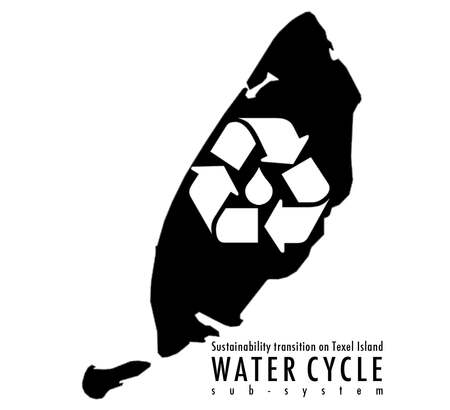
Part 1. Sustainability challenge and ambition, problem statement, and research question with regard to the sub-system
Current Situation| Problem statement- Challenges| Ambitions| Research Question| Potentials| Objectives| Water Cycle: S.W.O.T analysis of Sustainable Texel | References
1. Sustainability challenge and ambition, problem statement, and research question with regard to the sub-system
1.0 Table of Contents
1.1. Current Situation
1.2. Problem statement- Challenges
1.3. Ambitions
1.4. Research Question
1.5. Potentials
1.6. Objectives
1.7. Water Cycle: S.W.O.T analysis of Sustainable Texel
1.8. References
1.1. Current Situation
Water presence in Texel, as an island, is ubiquity taking into account that water surface (302,04km2) is almost twice in comparison with land one (302,04km2) and the yearly average amount of precipitation is estimated 160 million m3/year. [1]
With population of around 13.600 people and more than 700.000 tourists per year, during hot days in the summer season the water usage can be up to 7500m3, 20% more than the average usage and the yearly water consumption raises up to 1.110.367m3/year according to our calculations (more details on the next chapter: current situation).
Nowadays, water system for the island can be described as a linear configuration with the following series: The water supply in the island is achieved by an underwater pipeline system from two separate pipes from the main land, which is distanced only 2,5km from the island [1]. After the use, the consumed water is channelled to the sewage system. The amount of consumed water plus a part of rainwater return to the island system as sewage water and it is ended up in the sea, which is the the final step in the current linear system. Although the sewage treatment is sufficient also for the future needs, it presents problems, as we will explain later in the problem statement part and the next chapter. [3]
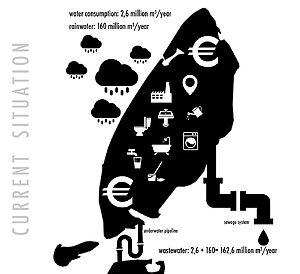
1.2. Problem statement- Challenges
In general, water issue has economic, environmental and social impact. The water challenges of the island are mainly related to the water supply system, the sewage system, natural disasters (floods+shortage), the wastewater and the amount of consumed water.
Firstly, although, the pipeline system seems an effective solution, there are several drawbacks that accompany water pipelines. Firstly, this kind of water supply makes the island water depended from the mainland, since there is a “water connection” between the two of them. Moreover, the pipeline system by itself presents a series of disadvantages. For instance, the actual construction but also maintenance of a major water pipeline is extremely expensive. With manufacturing, labor, installation and maintenance, pipeline projects can cost billions of dollars. Because in this project we have to deal with an existing situation, the attention is given to the maintenance, which must be done every day in order to keep the pipeline working effectively. Pipelines need to be monitored continually and water quality must be constantly checked. Furthermore the pipes can disrupt ecosystems, ruin scenery, and act as an obstruction. Underground pipelines require huge trenches to be dug, also disrupting the land.
In conclusion, pipelines from the mainland (as a recent solution in order to ensure independence from the mainland) are only temporary solutions to the problem. They are too expensive for future use due to high tariffs and you cannot count on safety. [4]
A brief research on the societal water demands on Texel has shown extreme weather caused floods and water shortages on the island in the past years. More specifically, last August heavy rains caused floods on several parts of Texel. On the second part of august 25 to 30 mm of rain has fallen. Despite the installed rain drainage system about 50 cm of water covered the Vliestraat in Oosterend. Other parts of Texel, such as De Cocksdork and Den Burg also experienced flooded streets, hotels and tourists housing. [5]
On the other hand Texel experienced a water shortage in July 2013 when a heat wave hit the Netherlands. A leakage of the pipeline system between the island and the shore reduced the available water capacity and trucks transporting water were used to fulfill the rising demands. Since the pipeline lies at a depth of approximately 25 meters and divers can only work on it in between tides it took nearly 4 months to repair the leak. [2]
These two incidents may be experienced more often as the weather in the Netherlands is becoming more and more extreme.
In addition, as the amount of visiting tourists is increasing, yearly water demand on Texel is likely to increase even more. A bigger capacity of both the drainage system and the water supply system would be needed in order to fulfill the future demands.
The last challenge is the amount of wastewater. Nowadays, there are no actions on the island regarding the reuse and recycle of wastewater and as a result, all the amount of water that falls on the surface of the island is challenged in the sewage system as wastewater.
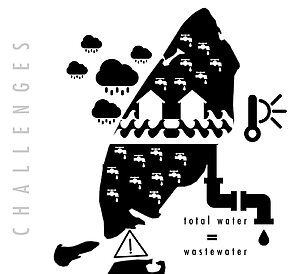
1.3. Ambitions
The term sustainability has been defined in many different ways. More generally, sustainability involves the simultaneous pursuit of economic prosperity, environmental quality and social equity and the need to perform not against a single bottom line but against this triple bottom line [12]. Our design tries to follow this “triple bottom-line approach” (TBL or 3BL), offering social, environmental and economic benefits. Starting with the social and environmental impacts, which will be instantly visible following by the economic benefits, which will be occurred some years later (analytically these benefits will be explained in the next chapters).
As a water cycle sub-system, our general ambition is to convert Texel in a sustainable and an autonomous island but also to reach the 3P needs (People (both locals and tourists), Private, Public) sectors.
Firstly, a key issue in our design is how to handle and combine the ‘top-down’ approach, which includes the strategic overview of the island as whole, and the ‘bottom-up’ approach, which articulates citizens’ but also tourists' demands.
Specifically, we aim to provide solutions that will support the realization of the vision of a self-sufficient Texel in 2020 and 100% “disconnection” from the mainland.The aim is to become autonomous regarding drinking water by developing its own sustainable system for water by exploiting the existing water sources and systems (rain and current sewage) but also the amount of wastewater.
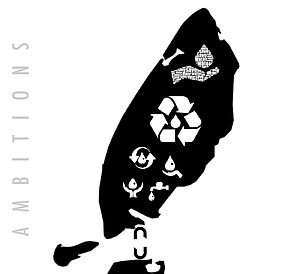
1.4. Research Question
The biggest question now is: do we accept the 'default traditional future', or do we strive to create our 'preferred future', keeping in mind the impact that our decisions we make today will have on future generations (considering 2065).
What water technologies, techniques and systems can be applied in Texel, in order to convert it in a sustainable island and simultaneously to provide its own drinking water in order to be self-sufficient and independent?
1.5. Potentials
The potentials are related to the water presence in the island but also to current innovation and sustainable water technologies.
In Texel, the annual precipitation is 996mm/year with the peak point during October (245mm) and the total area of the island is 161,12km2. This means that the annual amount of rainfall water in the island is estimated 160 million m3/year. The annual water demands of the island are 1,1 m3/year, which means that in an unrealistic scenario if a huge rain collector covers the whole island can be served around 1500% of the island needs. In a more realistic scenario, if the roofs of the existing buildings are used as rain catchment surfaces are able to cover a big percentage (maybe 30%) of their needs. [1] [6]
Furthermore, the island can exploit the seawater in order to produce fresh water but also energy.
Last but not least, it is the installation of innovative and sustainable solutions in order to recycle wastewater but also produce water through them.
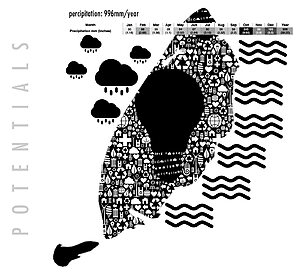
1.6. Objectives
Water is a fundamental resource challenge facing Texel, and its planning and management is a critical underpinning of Texel’s economy, society and environment.
Our sub-system objects are focused on four different perspectives related to the water cycle. These are summarized the R3P idea, which is explained by:
REDUCE (estimated percentage 10%)
REUSE (estimated percentage 20%)
RECYCLE (estimated percentage 80%)
PRODUCE (probably not the most efficient solution)
The R3P design aims to convert the linear configuration of the existing system to the circular one by achieving the water cycle. (these will be explained deeply in the chapter 4: the comparison of the current and future system)
To achieve the R3P concept we will look into the current state and previously attempted innovations technologies. Our goal is to find new solutions and to increase the efficiency of urban water systems by rethinking old paradigms and developing new solutions. Different technologies like rainwater harvesting, desalination of the seawater, effective stormwater management etc. can cover the R3P idea by reducing, reusing, recycling and producing.
Having a lot of different technologies in mind for reuse, recycle and production, we will be able to choose some of them or reject other organising the best future solution. As a result, our main objective is to develop an overall strategic approach achieving sustainable urban water management in the island of the future.
Finally, although people awareness seems to have limited influence, especially because we have to deal with a big amount of tourists, if we are able to reduce the daily needs at least 10% (according to the Dutch standards of water consumption 128l/p/d) it will be very beneficial.
From this we can start evaluating different possible sustainable technologies and designing different possible scenarios in all the four perspectives and depending on available time, we will decide to focus on one promising integrated system of possibly different technologies. An interesting possibility may be to discuss solutions with stakeholders involved like the municipality, HHNK (Hoogheemraadschap Hollands Noorderkwartier) sewage treatment company, PWN Water Company or even VVV tourism organization. [2] [10] [11]
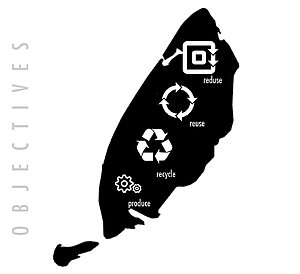
1.7. Water Cycle: S.W.O.T analysis of Sustainable Texel
A SWOT analysis (alternatively SWOT matrix) is a structured planning method used to evaluate the strengths, weaknesses, opportunities and threats (SWOT) involved in order to develop a strong proposal design. More specifically, in Texel case, it is the method strategy that can be followed in order to convert the Texel in a sustainable island in a more sufficient way. It involves specifying the objective of the proposal and then identifying the internal and external factors that are favorable and unfavorable to achieve that objective. [8]
S.W.O.T. is an acronym that stands for Strengths, Weaknesses, Opportunities, and Threats.
Strengths (internal positive factors): characteristics of the project that give it an advantage over others.
Weaknesses (negative factors): characteristics that place the project at a disadvantage relative to others and they have to improved.
Opportunities (potentials) (external positive factors): elements that the project could exploit to its advantage
Threats (external negative factors): elements in the environment that could cause trouble for the business or project
Our water cycle sub-system in Texel Island needs to ask and answer questions that generate meaningful information for each category to make the analysis useful and find their competitive advantage.
The following strengths, weaknesses, opportunities and threats have been identified for the water cycle sub-system of the Texel Island.
Strengths
Weaknesses
Opportunities
Threats
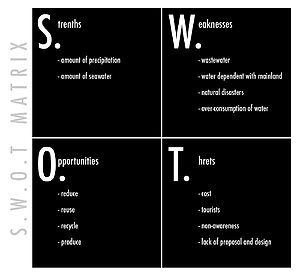
1.8. References
[1] http://en.wikipedia.org/wiki/Texel
[2] https://www.pwn.nl/overpwn/pers/Paginas/dossiertexel.aspx
[3] http://www.being-here.net/page/5867/water-cycle
[4] http://academic.evergreen.edu/g/grossmaz/SUPPESBJ/
[5] http://www.texelsecourant.nl/lees/18645/wateroverlast-door-hevige-regenbuien
[6] http://www.whatstheweatherlike.org/netherlands/texel.htm
[7] [http://en.wikipedia.org/wiki/Water_supply_and_sanitation_in_the_Netherlands]
[8] http://en.wikipedia.org/wiki/SWOT_analysis
[9] http://www.cbs.nl/en-GB/menu/themas/natuur-milieu/publicaties/artikelen/archief/2013/2013-3768-wm.htm
[10] http://www.vvvzeeland.nl/en/vvv-tourist-offices
[11] http://www.hhnk.nl/werk_in_de_buurt/gebiedspagina's/texel
[12] http://en.wikipedia.org/wiki/Triple_bottom_line


 Elia Galiouna
Elia Galiouna